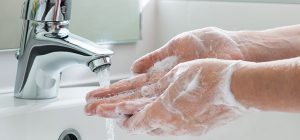
This post is also available in: Tiếng Việt (Vietnamese)

Authors:
Hands are an intermediary for the spread of hospital-acquired pathogens and antibiotic-resistant pathogens. Hands are easily contaminated during the care and treatment of patients because bacteria reside in the deep layers of the skin and around the nails.
Hand infections are a global health problem by increasing the incidence of bacterial infections in the hands. Bacteria often found on human skin or on bedspreads, beds and other frequently used and handled tools. These bacteria are less likely to multiply on the hands and can be easily removed by regular hand hygiene.
Therefore, hand hygiene aims to eliminate visible eye spots on the hands, prevent the spread of germs from the community to the hospital, prevent the spread of germs from the hospital to the community, prevent infections that patients can contract at the hospital.
You can wash your hands by rubbing your hands with an alcohol-based solution or by washing your hands with soap and clean water. The most effective way to ensure optimal hand hygiene is to use an alcohol-based hand sanitizer.
According to WHO hand hygiene guidelines, when alcohol-based hand sanitizers are available, they should be used as the preferred means of routine hand disinfection because they have the following advantages: eliminate most pathogens, including viruses, spend less time washing hands (20 to 30 seconds) good skin tolerance, no need for special equipment (clean water, sink, soap, towel). WHO also recommends that the use of alcohol-based soaps and alcohol hand sanitizers not be consecutive.
Hands should be washed with soap and water when visibly contaminated and contaminated with blood and body fluids, when suspected or determined to be susceptible to spores, or after defecated.
The effective process of hand hygiene, whether rubbing with alcohol or washing hands, depends on many factors: the quality of the product containing alcohol, the amount of product used, the duration of brushing or washing hands and surface rubbed or washed. Practice good hand hygiene when the skin is healthy, the nails are natural, short and unpainted with the hands and forearms without jewelry and without cover.
Washing your hands at the right time is one of the easiest ways to avoid getting sick and spreading bacteria. We should wash our hands whenever our hands are dirty, before wearing or removing contact lenses, otherwise they will spread germs from the hands to the eyes and cause eye infections. In addition, we should wash our hands after coughing or sneezing in our hands; after touching pets and toys; after waste disposal; after using the toilet. Besides, before and after having prepared and eaten, wound treatment, injection, we should also wash our hands.
The Ministry of Health has issued instructions for routine handwashing procedures, consisting of 6 steps:
Wash your hands for at least 30 seconds, each time at least 5 times.
It only takes around 30 seconds to wash your hands, but brings many benefits for ourselves and for those around us. Therefore, everyone should educate their readers about how to wash their hands well to protect their health and that of the community.
See more post:
References: